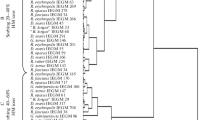Abstract
A gram-positive strain identified as Arthrobacter globiformis CECT 4500, tolerant to up to 1 M nitrate, was isolated from the grounds of a munitions factory. Under strict aerobic conditions, this bacterium used a wide variety of C-sources to obtain the energy required for growth, which took place when the nitrate concentration in the medium was below150 mM. Cells of this bacterium growing in the absence of nitrate were seen as individual cells or forming pairs,whereas cells grown in the presence of nitrate formed short filaments. With ethylene glycol as the C-source, optimal conditions for the full nitrate removal by Arthrobacter were established under laboratory conditions with wastewaters from the synthesis of dinitroethylene glycol.
Similar content being viewed by others
References
Abril MA, Michán C, Timmis KN & Ramos JL (1989) Regulator and enzyme specifities of the TOL plasmid-encoded upper pathway for degradation of aromatic hydrocarbons and expansion of the substrate range of the pathway. J. Bacteriol. 171: 6782–6790
Bender RA & Friedrich B (1990) Regulation of assimilatory nitrate reductase formation in Klebsiella aerogenesW70. J. Bacteriol. 172: 7256–7259
Cali BM, Micca JL & Stewart V (1989) Genetic regulation of nitrate assimilation of Klebsiella pneumoniaeM5a1. J. Bacteriol. 171: 2666–2672
Carter JP, Hsiao YH, Spiro S & Richardson DJ (1995) Soil and sediment bacteria capable of aerobic nitrate respiration. Appl. Environ. Microbiol. 61: 2852–2858
Clarkson WW, Ross BJB & Krishnamachari S (1991) Denitrification of high-strength industrial wastewaters. In: 45th Purdue Industrial Waste Conference Proceedings (pp 347–357). Lewis Publishers, Inc., Chelsea, Michigan
Egli T (1991) On multiple-nutrient-limited growth on microorganisms, with special reference to dual limitation by carbon and nitrogen substrates. Antonie van Leeuwenhoek 60: 225–234
Francis CW & Makin JB (1991) High nitrate denitrification in continuous flow-stirred reactors. Water Res. 11: 289–294
Guerrero MG, Vega JM & Losada M (1981) The assimilatory nitrate-reducing system and its regulation. Ann. Rev. Plant Physiol. 32: 169–204
Isken S & de Bont JAM (1996) Active efflux of toluene in a solvent-resistant bacterium. J. Bacteriol. 178: 6056–6058
Krishnamachari S & Clarkson WW (1993) Nitrite accumulation in the effluents from high-strength denitrification of industrial wastewaters. In: 47th Purdue Industrial Waste Conference Proceedings (pp 383–392). Lewis Publishers, Inc., Chelsea, Michigan
Lin JT, Goldman BS & Stewart V (1993) Structure of genes nasA and nasB, encoding assimilatory nitrate and nitrite reductases in Klebsiella pneumoniaeM5a1. J. Bacteriol. 175: 2370–2378
Magasanik B & Neidhardt FC (1987) Regulation of carbon and nitrogen utilization in Escherichia coliand Salmonella typhimurium. In: Neidhardt FC, Ingraham JL, Low KB, Magasanik B, Schaechter M & Umbarger HE (Eds) Cellular and Molecular Biology, Vol. 2 (pp 1321–1325). American Society of Microbiology, Washington D.C.
Manzano C, Candau P, Gomez-Moreno C, Relimpio AM & Losada M (1976) Ferredoxin-dependent photosynthetic reduction of nitrate and nitrite by particles of Anacystis nidulans. Mol. Cell Biochem. 10: 161–168
Nakano MM, Yang F, Hardin P & Zuber P (1995) Nitrogen regulation of nasA and the nasB operon, which encode genes required for nitrate assimilation in Bacillus subtilis. J. Bacteriol. 177: 573–579
Nikaido H(1996) Multidrug efflux pumps of gram-negative bacteria. J. Bacteriol. 178: 5853–5859
Ogawa KI, Akagawa E, Yamane K, Sun ZW, LaCelle M, Zuber P & Nakano MM (1995) The nasB operon and nasA gene are required for nitrate/nitrite assimilation in Bacillus subtilis. J. Bacteriol. 177: 1409–1413
Piñar G, Duque E, Haïdour A, Oliva JM, Sánchez-Barbero L, Calvo V & Ramos JL (1997) Removal of high concentrations of nitrate from industrial wastewater by bacteria. Appl. Environ. Microbiol. 63: 2071–2073
Pipke R & Amrheim N (1988) Isolation and characterization of a mutant of Arthrobactersp. strain GLP-1 which utilizes the herbicide glyphosate as its sole source of phosphorous and nitrogen. Appl. Environ. Microbiol. 54: 2868–2870
Pitt WW, Hancher CW & Patton BD (1981) Biological reduction of nitrates in wastewaters from nuclear processing using a fluidized-bed bioreactor. Nucl. Chem. Waste Manag. 2: 57–70
Ramos JL, Guerrero MG & Losada M (1982) Optimization of conditions for ammonia photoproduction from nitrate by Anacystis nidulanscells. Appl. Environ. Microbiol. 44: 1013–1019
Ramos JL, Haïdour A, Duque E, Piñar G, Calvo V & Oliva JM(1996) Metabolism of nitrate esters by a consortium of two bacteria. Nature/Biotechnology 14: 320–322
Ramos JL, Duque E, Rodriguez-Herva JJ, Godoy P, Haïdour A, Reyes F & Fernández-Barrero A (1997) Mechanisms for solvent tolerance in bacteria. J. Biol. Chem. 272: 3887–3890
Riet JV, Stouthamer AH & Planta RJ (1968) Regulation of nitrate assimilation and nitrate respiration in Aerobacter aerogenes. J. Bacteriol. 96: 1455–1464
Rodriguez-Herva JJ, Ramos-González MI & Ramos JL (1996) The Pseudomonas putidapeptidoglycan-associated outer membrane lipoprotein is involved in maintenance of the integrity of the cell envelope. J. Bacteriol. 178: 1699–1706
Sambrook J, Fritsch EF & Maniatis T (1989) Molecular cloning: a laboratory manual, 2nd ed. Cold Spring Harbor Laboratory, Cold Spring Harbor, New York
Snell FD & Snell T (1949) Colorimetric methods of analysis, vol. 2 (pp 802–807). Van Nostrand Co. NY
Stewart V (1988) Nitrate respiration in relation to facultative metabolism in enterobacteria. Microbiol. Rev. 52: 190–232
Walker JR Jr, Helfrich MV & Donaldson TL (1989) Biodenitrification of uranium refinery wastewaters. Environ. Progress 8: 97–101
Zumft WG (1992) The denitrifying prokaryotes. In: Balows A, Trüper HG, Dworkin M, Harder W & Schleifer KH (Eds) The Prokaryotes. A Handbook on the Biology of Bacteria, Ecophysiology, Isolation, Identification, and Applications (pp 554–582). Springer-Verlag, New York
Author information
Authors and Affiliations
Rights and permissions
About this article
Cite this article
Piñar, G., Ramos, J.L. A strain of Arthrobacter that tolerates highconcentrations of nitrate. Biodegradation 8, 393–399 (1997). https://doi.org/10.1023/A:1016080630009
Issue Date:
DOI: https://doi.org/10.1023/A:1016080630009




